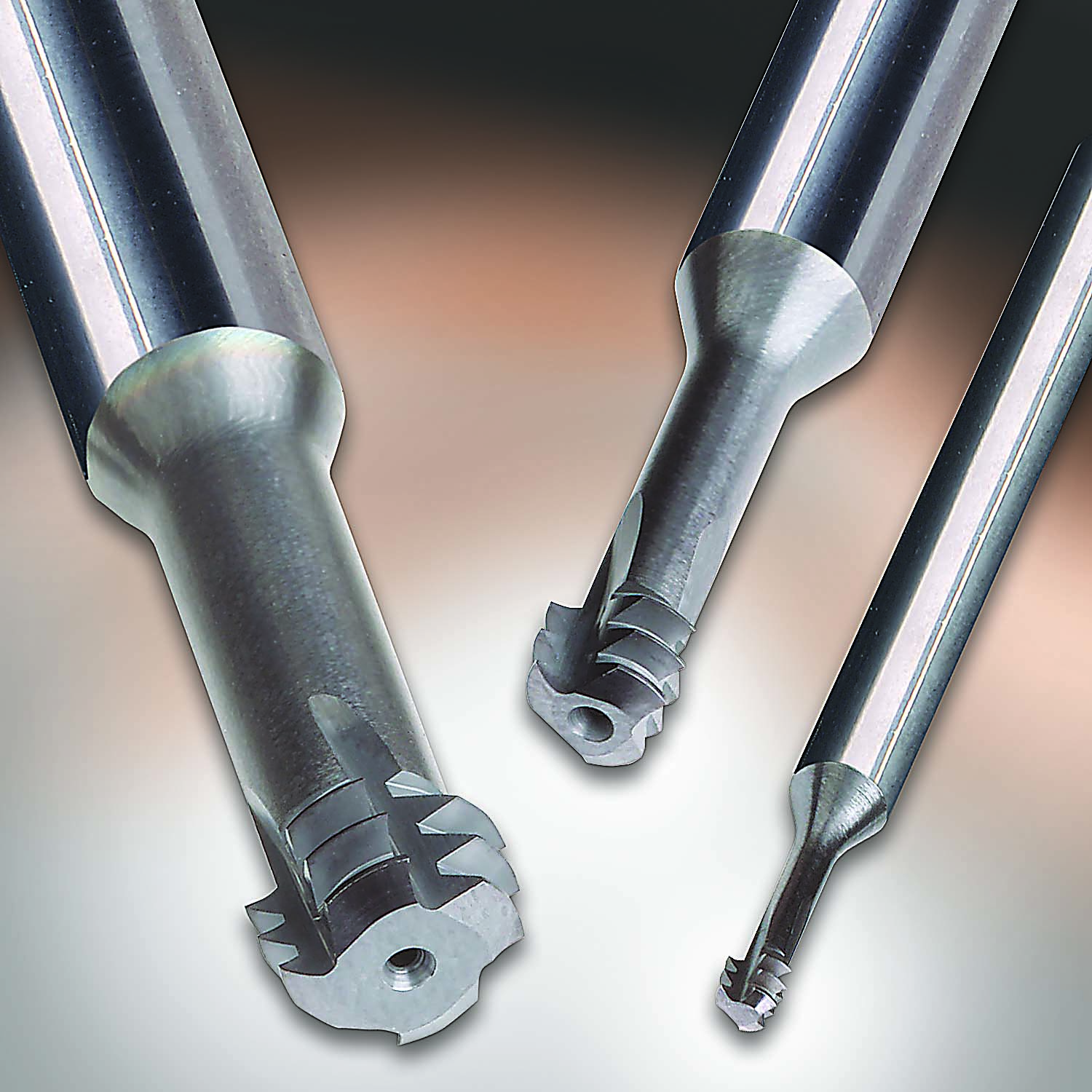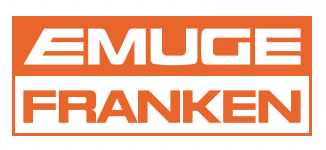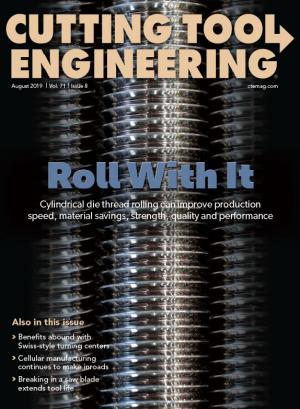When a component must resist corrosion while withstanding a high level of heat, such as one found in the combustion chamber of a jet engine, part designers often decide to make the part from a nickel-base superalloy. Whether Inconel 600, Haynes 230, Hastelloy B or another metal from that group, they all are challenging to thread or otherwise machine.
That is because those alloys have a high level of ductility, so they tend to easily workharden when cut, according to Marlon Blandon, product manager for thread milling at Emuge Corp., West Boylston, Massachusetts. As a result, prior to threading, drilling can workharden the surface of a hole to be threaded. A continuous threading application like tapping, in turn, can generate such a high level of heat that it workhardens the bore to the point that it can’t be threaded.

Emuge reports that its Threads-all ZGF S-Cut thread mills offer aggressive cycle time reductions and impart a fine finish when threading nickel-base alloys. Image courtesy of Emuge
Blandon suggests thread milling with the appropriate tool instead. The thread mill should be made of solid carbide and have a positive rake angle and sharp cutting edges. “We use a proprietary micrograin carbide that allows us to grind very sharp edges,” he said. “The finer the carbide grade, the easier it is to create a sharp edge.”
Those cutting edges should then be coated to protect them against heat. A TiCN coating can be deposited to resist heat without adding too much expense to a tool. However, a multilayer TiAlN coating is even more effective because once the coating is heated, it hardens more to enhance the protection, Blandon noted.
Hold On
Once an end user has the correct thread mill, a suitable toolholder is needed. According to Blandon, avoid ER collets at all costs because they are designed for linear cutting, either in and out or side to side but not for 3-axis circular interpolation, which thread milling requires.
In addition, shrink-fit toolholders might not be adequate because they often don’t have enough thickness to surround the tool shank and enable vibration-free thread milling, he added. Vibration produces chatter marks on threads, which require re-cutting. “You don’t want to make too many passes,” Blandon said, “because every time you make a pass, you are generating heat and the material is workhardening.”
A better choice is a holder with a side-locking screw that pushes the entire wall of the shank into the holder and improves rigidity, he said.
Blandon added that Emuge offers the FPC toolholding system. “It’s a gear-driven system that pulls the entire shank of the tool into a clamping sleeve. Then this clamping sleeve gets tightened with a specific torque into the holder itself. That is more than enough for thread milling.”
The next element for successfully threading nickel-base superalloys is to have the right program. To minimize heat, Blandon recommends reducing the cutting speed and taking a “big bite” of the workpiece so the cutting edge goes below any potentially workhardened zone. “We penetrate and grab as much as we can so the heat goes with the chip and doesn’t stay in the part.”
Circular Circuit
In addition, programming the thread mill to start cutting with a 180° entry curve instead of the typical 45° or 90° entry curve enables a “soft entry,” Blandon said. “This makes it so the point of the tool has a little bit more room to start from a small chip and work its way into a bigger chip.”
Creating more room is also important when applying external coolant. To enable coolant to effectively access where it is needed, users should select a single-plane thread mill that only engages a part with one line of teeth at once rather than a cutter with a full milling section, Blandon said. “It creates a lot of free cutting. You don’t have pressure on an entire milling section.”
Although the single-plane design reduces the amount of heat in the cut, he said it also extends the cycle time, which isn’t the highest consideration when thread milling an expensive, mission-critical part. “However, for substantially higher productivity there is a three-tooth solution with a left-hand helix flute—our unique ZGF S-Cut tool design—that simultaneously roughs and finish-cuts threads in one pass. It dramatically reduces cycle times while extending tool life.”
To help ensure successful thread milling, Blandon said Emuge usually provides complimentary programming instructions, including recommended speeds and feeds, with the thread mills it sells.
As industries place increased demands on heat-resistant part requirements, the need for tools to effectively thread and otherwise machine those parts follows.
“We have seen tremendous expansion in the aerospace industry, at least when it comes to jet engines,” Blandon said. “There is a high demand for tools for those heat-resistant materials.”
For more information about Emuge’s Threads-all ZGF S-Cut thread mills, view a video presentation at www.ctemag.com by scanning the QR code on your smartphone or entering this URL on your web browser: cteplus.delivr.com/2uac2
Contact Details
Related Glossary Terms
- alloys
alloys
Substances having metallic properties and being composed of two or more chemical elements of which at least one is a metal.
- chatter
chatter
Condition of vibration involving the machine, workpiece and cutting tool. Once this condition arises, it is often self-sustaining until the problem is corrected. Chatter can be identified when lines or grooves appear at regular intervals in the workpiece. These lines or grooves are caused by the teeth of the cutter as they vibrate in and out of the workpiece and their spacing depends on the frequency of vibration.
- coolant
coolant
Fluid that reduces temperature buildup at the tool/workpiece interface during machining. Normally takes the form of a liquid such as soluble or chemical mixtures (semisynthetic, synthetic) but can be pressurized air or other gas. Because of water’s ability to absorb great quantities of heat, it is widely used as a coolant and vehicle for various cutting compounds, with the water-to-compound ratio varying with the machining task. See cutting fluid; semisynthetic cutting fluid; soluble-oil cutting fluid; synthetic cutting fluid.
- cutting speed
cutting speed
Tangential velocity on the surface of the tool or workpiece at the cutting interface. The formula for cutting speed (sfm) is tool diameter 5 0.26 5 spindle speed (rpm). The formula for feed per tooth (fpt) is table feed (ipm)/number of flutes/spindle speed (rpm). The formula for spindle speed (rpm) is cutting speed (sfm) 5 3.82/tool diameter. The formula for table feed (ipm) is feed per tooth (ftp) 5 number of tool flutes 5 spindle speed (rpm).
- ductility
ductility
Ability of a material to be bent, formed or stretched without rupturing. Measured by elongation or reduction of area in a tensile test or by other means.
- gang cutting ( milling)
gang cutting ( milling)
Machining with several cutters mounted on a single arbor, generally for simultaneous cutting.
- interpolation
interpolation
Process of generating a sufficient number of positioning commands for the servomotors driving the machine tool so the path of the tool closely approximates the ideal path. See CNC, computer numerical control; NC, numerical control.
- milling
milling
Machining operation in which metal or other material is removed by applying power to a rotating cutter. In vertical milling, the cutting tool is mounted vertically on the spindle. In horizontal milling, the cutting tool is mounted horizontally, either directly on the spindle or on an arbor. Horizontal milling is further broken down into conventional milling, where the cutter rotates opposite the direction of feed, or “up” into the workpiece; and climb milling, where the cutter rotates in the direction of feed, or “down” into the workpiece. Milling operations include plane or surface milling, endmilling, facemilling, angle milling, form milling and profiling.
- milling machine ( mill)
milling machine ( mill)
Runs endmills and arbor-mounted milling cutters. Features include a head with a spindle that drives the cutters; a column, knee and table that provide motion in the three Cartesian axes; and a base that supports the components and houses the cutting-fluid pump and reservoir. The work is mounted on the table and fed into the rotating cutter or endmill to accomplish the milling steps; vertical milling machines also feed endmills into the work by means of a spindle-mounted quill. Models range from small manual machines to big bed-type and duplex mills. All take one of three basic forms: vertical, horizontal or convertible horizontal/vertical. Vertical machines may be knee-type (the table is mounted on a knee that can be elevated) or bed-type (the table is securely supported and only moves horizontally). In general, horizontal machines are bigger and more powerful, while vertical machines are lighter but more versatile and easier to set up and operate.
- rake
rake
Angle of inclination between the face of the cutting tool and the workpiece. If the face of the tool lies in a plane through the axis of the workpiece, the tool is said to have a neutral, or zero, rake. If the inclination of the tool face makes the cutting edge more acute than when the rake angle is zero, the rake is positive. If the inclination of the tool face makes the cutting edge less acute or more blunt than when the rake angle is zero, the rake is negative.
- shank
shank
Main body of a tool; the portion of a drill or similar end-held tool that fits into a collet, chuck or similar mounting device.
- superalloys
superalloys
Tough, difficult-to-machine alloys; includes Hastelloy, Inconel and Monel. Many are nickel-base metals.
- tapping
tapping
Machining operation in which a tap, with teeth on its periphery, cuts internal threads in a predrilled hole having a smaller diameter than the tap diameter. Threads are formed by a combined rotary and axial-relative motion between tap and workpiece. See tap.
- threading
threading
Process of both external (e.g., thread milling) and internal (e.g., tapping, thread milling) cutting, turning and rolling of threads into particular material. Standardized specifications are available to determine the desired results of the threading process. Numerous thread-series designations are written for specific applications. Threading often is performed on a lathe. Specifications such as thread height are critical in determining the strength of the threads. The material used is taken into consideration in determining the expected results of any particular application for that threaded piece. In external threading, a calculated depth is required as well as a particular angle to the cut. To perform internal threading, the exact diameter to bore the hole is critical before threading. The threads are distinguished from one another by the amount of tolerance and/or allowance that is specified. See turning.
- titanium aluminum nitride ( TiAlN)
titanium aluminum nitride ( TiAlN)
Often used as a tool coating. AlTiN indicates the aluminum content is greater than the titanium. See coated tools.
- titanium carbonitride ( TiCN)
titanium carbonitride ( TiCN)
Often used as a tool coating. See coated tools.
- toolholder
toolholder
Secures a cutting tool during a machining operation. Basic types include block, cartridge, chuck, collet, fixed, modular, quick-change and rotating.
- web
web
On a rotating tool, the portion of the tool body that joins the lands. Web is thicker at the shank end, relative to the point end, providing maximum torsional strength.
- workhardening
workhardening
Tendency of all metals to become harder when they are machined or subjected to other stresses and strains. This trait is particularly pronounced in soft, low-carbon steel or alloys containing nickel and manganese—nonmagnetic stainless steel, high-manganese steel and the superalloys Inconel and Monel.
Contributor
Emuge Corp.
800-323-3013
www.emuge.com



